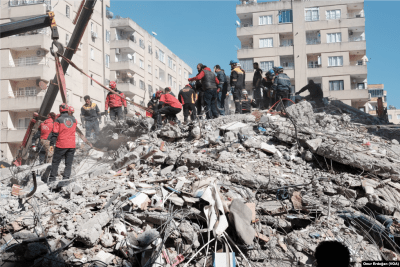
Turkey’s economy was weak well before February’s devastating earthquakes, but damage to the country’s agricultural sector, one of its most important industries, could push Turkey over the edge. With the growing season fast approaching, farmers in the earthquake zone need immediate assistance to stave off nationwide food shortages.
Food-related consequences of the disaster have already surfaced. Within a week of the quakes, the price of beef surged after destruction of the region’s slaughterhouses. Supplies were also affected, as the hardest-hit provinces account for 12% of Turkey’s cattle industry. Since January, a kilogram of meat has climbed nearly 40%, to 180 lira (about US$9.50).
Other food commodities also have been steadily increasing. In February, a basket of food increased 7%, with vegetables surging 24% and fruits 10%. Foodstuffs inflation is bound to continue, especially if food production in earthquake-hit areas doesn’t rebound quickly.
Inflation isn’t a new problem in Turkey. The Turkish Statistical Institute reported that the yearly inflation rate for January 2023 was 57%, while ENAG, an independent research institute, puts it at 121%.
Leaders had been predicting that inflation would decline before elections in May, but that now seems unlikely. An estimated $25 billion in earthquake-related production losses will add to inflationary pressure, especially food prices.
The 10 provinces hit by the earthquakes play an important role in feeding the country. Together they account for 15.5% of Turkey’s total agricultural output, with production worth more than 85 billion lira. Around 20% of that is in vegetables. More than 13% of Turkey’s registered farmers are located in this region, and most live in villages that were destroyed and remain cut off from aid.
Some farmers have been compensated for their losses. Turkey’s Agricultural Insurance Pool (TARSIM) has paid out 11 million lira in insurance claims since the disaster. But only about 20% of Turkey’s farmers are insured, and many vegetable growers are not, leaving the bulk of the country’s food producers reliant on small government grants for production.
Turkey’s fields should soon be sown with millet, rice, soybeans and sunflower. To meet this seasonal calendar, and to help the country avert a food shortage, growers need support in securing seeds, fertilizers, and diesel fuel. The Ministry of Agriculture and Forestry has said it will provide cash payments of 2.8 billion lira ($148 million) for registered, earthquake-stricken farmers.
Yet even if these promises are kept, the issue of labor remains unclear. How will those who lost their homes, families and friends be persuaded to return to work and till the land? And if not them, then who?
Labor shortages may be the biggest hurdle to overcome for Turkey’s agricultural sector. Some 100,000 tons of lemons in Hatay province, which exported $186 million worth of citrus in 2022, remain on trees with no one to collect them. Another 300,000 tons are stuck in depots waiting to be distributed.
Agriculture is a time-sensitive industry, and the window for picking fruit and planting vegetables is quickly closing. The government needs an action plan immediately.
Unfortunately, Ankara doesn’t appear up to the task. Now, the government is simply struggling to dig out. The UN Development Program estimates that as much as 210 million tons of rubble was generated when thousands of buildings collapsed in the quakes, an unparalleled amount of waste for a single disaster. By comparison, the 1999 earthquake in Marmara, Turkey, produced 13 million tons.
For the country’s leaders, just clearing debris has proved controversial. Turks have seen images on social media showing rubble being dumped into lakes, rivers, and along the coast, disposal methods that could cause irreversible environmental damage.
One widely shared image shows mounds of waste piling up on Hatay’s seacoast, home to turtles and more than 300 different bird species. A video from a village in Gaziantep shows debris being dumped into retention ponds that farmers use for their livestock.
Turkey is facing a recovery of epic proportions. In a recent report, the World Bank estimated direct physical damage from the quakes to be $34.2 billion, about 4% of Turkey’s 2021 GDP. Rebuilding costs could be twice that amount or even more. Louisa Vinton, the UNDP’s representative in Turkey, said the damage amounted to more than $100 billion.
While little could have been done to earthquake-proof Turkey’s agricultural network, how the government responds will go a long way to protecting the sector from future disasters. Failing to provide for and fulfill the needs of farmers will give rise to long-lasting food security issues.
Turkey can still avoid another crisis, but to do so, a long-term and sustainable rural economic infrastructure plan needs to be established to keep farmers working, and the country fed.
This article was provided by Syndication Bureau, which holds copyright.

